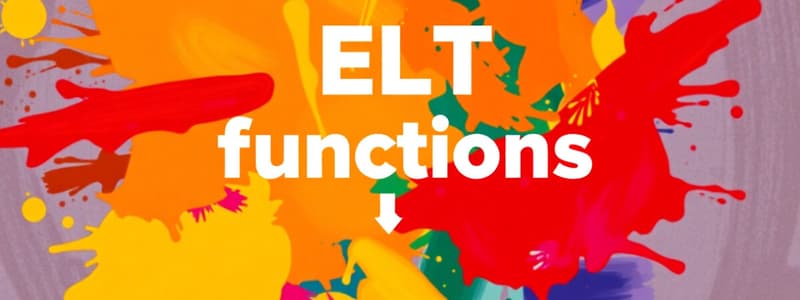Podcast
Questions and Answers
Which of the following best describes the primary role of understanding language functions in English Language Teaching (ELT)?
Which of the following best describes the primary role of understanding language functions in English Language Teaching (ELT)?
- To focus solely on the accurate pronunciation of English words and phrases.
- To communicate effectively and appropriately in various real-world situations. (correct)
- To memorize a wide range of vocabulary and grammatical structures.
- To understand the historical evolution of the English language.
A student says, 'I'm really sorry about breaking your pen.' Which language function is the student primarily using?
A student says, 'I'm really sorry about breaking your pen.' Which language function is the student primarily using?
- Suggesting
- Apologizing (correct)
- Requesting
- Informing
Which of the following is the most formal exponent for inviting someone to a meeting?
Which of the following is the most formal exponent for inviting someone to a meeting?
- Come to the meeting, okay?
- Hey, wanna come to the meeting?
- Why don't you come to the meeting?
- We would be most honored if you would attend the meeting. (correct)
Which of these scenarios exemplifies the language function of 'Negotiating'?
Which of these scenarios exemplifies the language function of 'Negotiating'?
Which of the following best illustrates the use of a 'social function' of language?
Which of the following best illustrates the use of a 'social function' of language?
How can the same language exponent express different language functions?
How can the same language exponent express different language functions?
Choose the option that is most appropriate for the language function 'Expressing Purpose'.
Choose the option that is most appropriate for the language function 'Expressing Purpose'.
Which is the most neutral way to ask someone to close the window?
Which is the most neutral way to ask someone to close the window?
Which of the following best exemplifies a language function focused on 'negotiating'?
Which of the following best exemplifies a language function focused on 'negotiating'?
A student is learning the language function of 'complaining.' Which activity would be MOST effective in helping them grasp this concept?
A student is learning the language function of 'complaining.' Which activity would be MOST effective in helping them grasp this concept?
Which teaching approach places the MOST emphasis on reflecting natural communication patterns when presenting a new language function?
Which teaching approach places the MOST emphasis on reflecting natural communication patterns when presenting a new language function?
A teacher wants students to practice the language function of 'offering.' Which activity would be most suitable?
A teacher wants students to practice the language function of 'offering.' Which activity would be most suitable?
In teaching language functions, why is it important to move linguistic forms 'out of the dialogue to see in isolation'?
In teaching language functions, why is it important to move linguistic forms 'out of the dialogue to see in isolation'?
Which activity is LEAST likely to be effective for practicing language functions in a communicative classroom?
Which activity is LEAST likely to be effective for practicing language functions in a communicative classroom?
A student says, "I feel this approach might not be the best for our team." Which language function is the student demonstrating?
A student says, "I feel this approach might not be the best for our team." Which language function is the student demonstrating?
Which of the following is the most effective way to ensure that language function exercises are meaningful and realistic?
Which of the following is the most effective way to ensure that language function exercises are meaningful and realistic?
How do 'information gap tasks' primarily aid in practicing language functions?
How do 'information gap tasks' primarily aid in practicing language functions?
Why is 'contextualization' emphasized as an effective strategy for teaching language functions?
Why is 'contextualization' emphasized as an effective strategy for teaching language functions?
Flashcards
Language Function
Language Function
The communicative purposes of language, like requesting or suggesting.
Why understand functions?
Why understand functions?
Allows learners to communicate effectively in various situations.
Common EFL functions
Common EFL functions
Giving information, expressing opinions, making requests, etc.
Main Function Categories
Main Function Categories
Signup and view all the flashcards
Language Exponent
Language Exponent
Signup and view all the flashcards
Functions & Exponents relationship
Functions & Exponents relationship
Signup and view all the flashcards
Levels of Formality
Levels of Formality
Signup and view all the flashcards
Social Functions
Social Functions
Signup and view all the flashcards
Greeting Function
Greeting Function
Signup and view all the flashcards
Farewell Function
Farewell Function
Signup and view all the flashcards
Complimenting Function
Complimenting Function
Signup and view all the flashcards
Complaining Function
Complaining Function
Signup and view all the flashcards
Apologizing Function
Apologizing Function
Signup and view all the flashcards
Requesting Function
Requesting Function
Signup and view all the flashcards
Offering Function
Offering Function
Signup and view all the flashcards
Thanking Function
Thanking Function
Signup and view all the flashcards
Persuading Function
Persuading Function
Signup and view all the flashcards
Negotiating Function
Negotiating Function
Signup and view all the flashcards
Study Notes
- Functions in ELT refer to the communicative purposes of language use, such as requesting, apologizing, or suggesting.
- Understanding language functions helps learners communicate effectively and adapt their language to achieve specific goals.
- Richards, J. C., & Schmidt, R. (2010) define functions in the Longman dictionary of language teaching and applied linguistics.
Common Functions
- Informing: giving information, reporting, explaining
- Requesting: making requests, asking for permission, asking for clarification
- Inviting: suggesting, offering suggestions, recommending, proposing ideas
- Expressing: opinions, sharing feelings, describing experiences, expressing wishes, purpose, cause and effect, contrast, concession
- Apologizing: offering apologies, expressing regret, making amends
- Negotiating: Reaching agreements, compromising, persuading
Language Exponents
- Exponents are the language used to express a function and can express different functions depending on the context.
- A single function can be expressed through different exponents depending on the level of formality.
- Formal exponents are serious and careful and used in formal situations.
- Informal exponents are relaxed and used in informal situations.
- Neutral exponents fall between formal and informal and are used in neutral situations.
- Come for lunch, come for lunch with us, would you like to come for lunch with us, why don’t you come for lunch with us, we would be very pleased if you could join us for lunch are all used as exponents of inviting someone to lunch.
Social Functions
- Social functions are used to establish and maintain social relationships.
- Greeting: Initiating or responding to social interactions, for example, "Hello!", "How are you?"
- Farewell: Ending conversations politely, for example, "Goodbye!", "See you later!"
- Complimenting: Praising or expressing admiration, for example, "You look great!", "Nice job!"
- Complaining: Expressing dissatisfaction or grievances, for example, "This is unfair!", "I'm really upset about this."
- Apologizing: Expressing regret or admitting fault, for example, "I'm sorry for being late.", "I apologize for the mistake."
- Requesting: Asking for something or seeking permission, for example, "Can you help me?", "May I borrow your pen?"
- Offering: Giving something to someone, for example, "Would you like some tea?", "Here's a gift for you."
- Thanking: Expressing gratitude, for example, "Thank you!", "I appreciate your help."
Rhetorical Functions
- Rhetorical functions are used to persuade or influence others and can be used in academic spoken or written texts: defining, cause and effect, purpose, addition, and concession.
- Persuading: Convincing someone to do something or believe something, for example, "You should try this restaurant.", "It's important to vote."
- Negotiating: Reaching agreements or compromises, for example, "Let's find a middle ground.", "Can we agree on this solution?"
- Suggesting: Offering advice or recommendations, for example, "You might want to consider this option.", "I suggest you take a break."
- Expressing Opinions: Sharing personal views or beliefs, for example, "In my opinion, this is the best choice.", "I believe we should take action."
- Expressing Feelings: Sharing emotions or attitudes, for example, "I feel strongly about this issue.", "I'm excited about the project."
- Explaining: Providing reasons or justifications, for example, "The reason is...", "This is because..."
Teaching Language Functions
-
Presenting the Function in a Dialogue
- Select real interactions between real speakers, set the scene, and indicate the role relationship between the speakers.
- Ensure the target function occurs naturally and represents what native speakers use most frequently in that situation.
- Avoid dialogues that seem like an artificial context for the function.
-
Highlighting the Function in the Dialogue
- Exploit the dialogues and ask students to discover instances of the target function (linguistic exponents) and underline them.
- Develop a grid that allows a visual display of the language forms related to the social variables of the situation.
- Transfer the linguistic forms of the target function out of the dialogue to see in isolation and arrange them according to formality level.
-
Practice Stage
- Focus on accurately producing and supplying the appropriate linguistic form of the function.
- Provide exercises on the linguistic forms of the target function.
- Use meaningful and realistic exercises and tasks.
- Make sure the exercises are not simply a mechanical transformation where students can supply the correct linguistic form for the function without considering the meaning of the whole exchange.
- Use pair and group practice wherever possible.
- Provide enough practice exchanges so that students can practice efficiently.
- Encourage the exchange of personal information during communication.
- Focus on accurately producing and supplying the appropriate linguistic form of the function.
Effective Strategies
- Contextualization: Use real-life situations and scenarios.
- Role-playing: Practice communication in different roles.
- Authentic Materials: Use real-world texts and media.
- Focus on Fluency: Encourage natural and spontaneous language.
Sample Activities
- Information gap tasks: Students have a problem and must communicate to solve it.
- Opinion gap tasks: Students state their personal preferences, attitudes, or feelings.
- Role-play (drama simulation): Students freely act out roles and situations after initial cues, often simulating real-life actions and experiences.
- Games: Production and use of language in the setting of a language game.
- Interviews: Students obtain information from each other.
- Discussion:
Studying That Suits You
Use AI to generate personalized quizzes and flashcards to suit your learning preferences.




